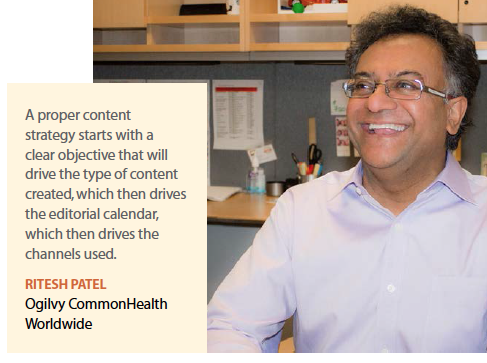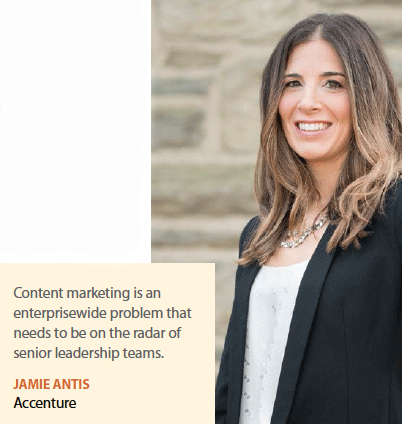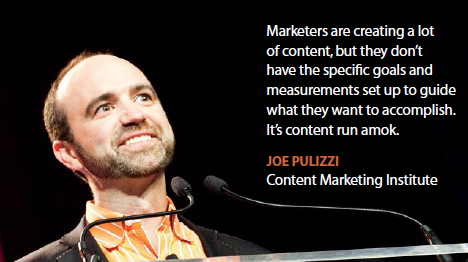 More than half — 58% — of the pharma/biotech industry is spending more than $50 million in content development every year, but much of that content is not connected to a solid objective, which means money and time are being wasted. In a recent Accenture study, only 11% of pharma/biotech marketers reported they have a clear content management strategy and only 9% feel their organization has clear marketing objectives, but 93% report the volume of digital content and assets they manage is higher today than it was two years ago.
More than half — 58% — of the pharma/biotech industry is spending more than $50 million in content development every year, but much of that content is not connected to a solid objective, which means money and time are being wasted. In a recent Accenture study, only 11% of pharma/biotech marketers reported they have a clear content management strategy and only 9% feel their organization has clear marketing objectives, but 93% report the volume of digital content and assets they manage is higher today than it was two years ago.
“The fact that the industry is investing heavily in a lot of content without a strategy makes us believe companies are not investing wisely," says Jamie Antis, managing director, Accenture Life Sciences, Intelligent Marketing Services at Accenture. Especially since the report shows that 97% of respondents within pharma said they spent more time managing the operational details of content today than actually focusing on its alignment to the overall marketing strategy. “This number is significantly higher for the pharma industry than for some of the other industries that we have polled," Ms. Antis says.
Many pharma marketers are perhaps mistakenly thinking that if they have content up on a website or a video connected to a tweet that they are using content marketing methods. However, if the content does not drive or change the consumer behavior, it has no value to the marketer and possibly not even the consumer.
“Right now content marketing is considered copy, and it’s not copy," says Ritesh Patel, chief digital officer at Ogilvy CommonHealth Worldwide.
“It’s not called a copy writing strategy. It’s a content marketing strategy and should live within the overall marketing strategy. There are lots of marketers who still don’t understand the difference between a content strategy and a copy strategy."
All too often, marketers will create online copy and focus only on search engine optimization and that is only one small part of content marketing. Mr. Patel often hears: “It’s a website, so write the copy and make sure it’s tagged for SEO." This is not a content marketing strategy, he adds.
Joe Pulizzi, founder and executive director of the Content Marketing Institute, defines a content marketing strategy as the creation of valuable, relevant, compelling information published on a consistent basis that helps build a relationship with a consumer and follows that consumer throughout his or her buyer’s journey.
The proliferation of digital channels that provide easy access and practically no production or publication costs along  with more and more consumers looking for information online has greatly reduced the former barriers to print publishing, making it almost too easy to post content.
with more and more consumers looking for information online has greatly reduced the former barriers to print publishing, making it almost too easy to post content.
“We think because we can publish, we should, and we publish content all over the place and most of it doesn’t work," Mr. Pulizzi says. “It’s content run amok."
Without a definitive strategy, all that content just becomes useless noise.
Mr. Pulizzi says most companies, especially large companies, have no formal documented content marketing strategy, instead, they say: “we should do a blog; we should be on Facebook; we should do Twitter; we should write articles." They are creating a lot of content, but they don’t have the specific goals and measurements set up to guide what they want to accomplish.
Strategy First, Then Content
A good content marketing plan must start with a goal that meets an overall objective of the marketing strategy. According to the recent Accenture report, only 11% of respondents within the pharma and biotech sectors reported having a clearly documented content strategy that met both current and future needs. Compared with other industries, which reported around 42%, this percentage is very low. “Content strategy and objectives within the pharma industry are not clear," Ms. Antis says. “Creating a strategy truly requires an organizational shift and it’s not just a process change or an implementation of a technology."
First, the C-suite — not just the marketing organization — needs to determine the overall objective for a content marketing approach. According to the Accenture results, 90% of respondents felt C-level executives were responsible for driving the content strategy; with 35% pointed to the CEO.
“This tells me that there is an acknowledgement within the industry that content marketing is an enterprisewide problem and it needs to be on the radar of the senior leadership team within the organization to resolve it," Ms. Antis says. “Pharma leaders will need to evaluate what changes need to happen within their organizational models to help them achieve the strategy, which is going to require them to break down barriers between the business and IT," she adds. “It’s going to require them to create better alignment with their compliance and regulatory teams and the way content is reviewed and approved."
The siloed approach in which companies create content creates a lack of alignment that distorts the brand message.
“Until pharma companies break those silos and start thinking about the brand and the content holistically, they will always struggle," Mr. Patel says.
“I think some brand managers understand the value of content, but they only look at it from a clinical, medical, or a patient-adherence program perspective. Proper content strategy should drive everything else a company does. Marketers need to determine what type of content will help realize the goal. The answer will drive the type of content a company needs to create, which then drives the editorial calendar, which then drives the channels, and that drives the content use strategy, which ultimately defines the copy you need to create."
To help determine the best objective to build a strategy around content, marketers must first identify a pain point and determine how a content marketing approach can solve the problem. The focus needs to be on a specific audience, its needs, which type of content vehicle to use, and choosing one key platform to start with, such as a website or YouTube, and consistently deliver relevant content over time.
“This is the winning formula," Mr. Pulizzi says. “This is how great content marketing starts, and yet the majority of brands don’t follow this process."
Consistency and Patience
Once a content marketing plan is in place, pharma companies need to realize they are in it for the long haul, and creating copy is a continual process. Mr. Pulizzi says what often happens is that a company will set up a blog, but not  invest the time to refresh the content on a consistent basis. Furthermore, he says once a content channel has been established, curators need to publish consistently.
invest the time to refresh the content on a consistent basis. Furthermore, he says once a content channel has been established, curators need to publish consistently.
“They treat it like a campaign that has an end, but content marketing is a marathon and not a sprint," he explains. “It takes a long time. Content marketing really never stops; it always changes and you adapt to it, but you never stop."
As consumers conduct more and more research on their own, a company can be left out of the buying process if consumers are not finding consistent, engaging information around the brand. It’s crucial to keep the consumer engaged with the brand long term because more than 60% of the consumer’s buying journey is complete before he or she even makes a buying decision.
“If companies are not involved in those early stages of the buying process, they will get left out and that’s a big issue," Mr. Pulizzi says.
In an industry that likes to see quick results, content marketing will require much patience and a new mindset. Brands will not see results in six months from a content marketing approach, and Mr. Pulizzi says anyone with expectations of monetizing that in six months or less shouldn’t even bother to start.
“Go buy advertising; go interrupt people," Mr. Pulizzi says. “It’s very hard to build a loyal relationship with somebody in six months or less."
A consistent message needs to be aligned across all channels, as well, which is difficult to do within the fragmented pharma marketing process.
For example, when a company launches a new drug, there will be a huge amount of content created across multiple channels. The problem is the process is all siloed. The agency of record is responsible for the brand. The digital agency creates the digital content. A media agency manages the media content. A search engine agency tags the content. “But none of this rolls up to the brand," Mr. Patel says.
For example, picture a physician sitting at home watching TV. He or she views a DTC ad and knowing that patients will be asking about it, he goes to the website of the brand to find out more. Chances are very good that the experience of the TV ad from a content perspective is completely disconnected from the website material. The next day a sales rep presents information about the same drug on the iPad in the office, and that brand experience and messaging is completely different to what’s on the website and the TV ad. The doc attends a medical meeting where the pharmaceutical company is promoting the drug, and the experience of the brand at the medical meeting is completely disconnected from every other experience he or she has had previously.
“The brand is diluted because there are different experiences depending on who you are, what you’re dealing with, when you’re interacting with it, and what content you’re interacting with," Mr. Patel says. “Silos are killing this industry’s best efforts. The industry needs to create content that is relevant, for the moment it is required and has the same look and feel and then start to create subpieces that can then be fed into the marketplace from a content marketing perspective that drives the same experiences."
Facing Measurement Challenges
 The amount of content being created may have increased, but unfortunately reports state that engagement with consumers has not increased.
The amount of content being created may have increased, but unfortunately reports state that engagement with consumers has not increased.
Determining what works requires some patience, and both short-term and long-term key performance indicators (KPI). Mr. Pulizzi says the one measurement question that covers all KPIs is whether or not the content is influencing consumer behavior over time.
Measurements include analysis of buying patterns, customer relationship management databases, subscriber databases, etc. But those metrics take some time — often more than a year — and a lot of companies aren’t willing to wait that long to determine if a program is working or not.
However, there are trackable short-term factors, vanity metrics, for example, website traffic, quality leads, or qualitative feedback from customers, that point to whether certain pieces of content have helped them to make a decision.
“These don’t necessarily line up directly with revenue right away, but they will show that a plan is headed in the right direction," Mr. Pulizzi says.
The timeframe to get solid long-term data would have to surpass the length of time it takes for a buyer to go through the journey to determine if the content had impact over the buyer’s decision making. These data sets could take up to two years to acquire.
For large brands that are not so patient, there is the option of purchasing a media company’s blogs and influencer sites to get a jump on the competition.
This will be a trend emerging within the next five years as companies look for more immediate results. According to Mr. Pulizzi, putting a consistent publishing program behind building a brand and positioning the pharma company as a thought leader and educator will lead to long-term benefits as it has for other industries.
“A content marketing approach is probably one of the best things a company can do to build a reputation," he says. (PV)

















